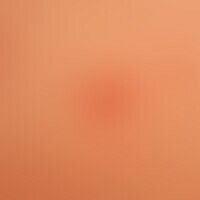Image diagnoses for "red"
901 results with 4543 images
Results forred

Sweet syndrome L98.2
Dermatosis, acute febrile neutrophils (Sweet syndrome): acutely occurring (existing since 1 week) highfebrile exanthema with involvement of the trunk, face and capillitium as well as the upper extremities. feeling of illness, myalgia, arthritis. high inflammation parameters. cause unknown (viral infection in combination with the intake of anti-inflammatory drugs?).

Eccema molluscatum B08.1
Eccema molluscatum: Multiple very itchy, inflamed nodules/papules of different sizes in the area of the axilla

Psoriasis capitis L40.8
Psoriasis capitis: diffuse reddening of the entire capillitium with coarse lamellar scaling. Here in a 42-year-old patient with extensive psoriasis of the entire integument. Typically, the changes exceed the forehead-hairline.

Congestive dermatitis I83.1
stasis dermatitis: flat, sharply limited plaque of the entire right lower leg. lipofasciosclerosis in case of a previously known CVI with beginning papillomatosis cutis lymphostatica. condition after leg ulcer. currently distinct exudation, lymphorrhoea as well as secondary bacterial colonization.

Drug effect adverse drug reactions (overview) L27.0

Thrombangiitis obliterans I73.1
Thrombangiitis obliterans. 32-year-old patient with a nicotine abuse lasting for years and a patchy palmar erythema existing since 6 months as well as mummified fingertip necroses.
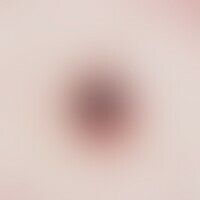
Pyogenic granuloma L98.0
Granuloma pyogenicum (pyogenic granuloma) Rapidly growing, bluish-black, soft, slightly bleeding tumour. Remark: the black colour was caused by thrombosis in the tumour parenchyma.

Asymmetrical nevus flammeus Q82.5
Vascular (capillary) malformation (so-called naevus flammeus): Congenital, generalized, spotty erythema from the scalp to the sole of the foot in an 8-year-old boy, developed according to age.

Sarcoidosis of the skin D86.3
Sarcoidosis: anular or circulatory chronic sarcoidosis of the skin. persisting for several years. onset with small symptomless papules with continuous appositional growth and central healing. no detectable systemic involvement.

Rosacea erythematosa L71.8
DD: Rosacea erythematosus- here lupus pernio: 63-year-old female patient with reddish-livid plaque of the nose and previously known chronic pulmonary sarcoidosis.
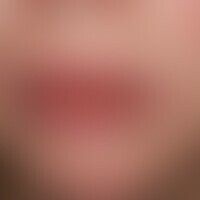
Stevens-johnson syndrome L51.1
Stevens-Johnson syndrome: acute, extensive, painful erosions of the red of the lips, the lip mucosa, the tongue and the gingiva in an 18-year-old woman.

Lupus erythematodes chronicus discoides L93.0
Lupus erythematodes chronicus discoides : Solitary blurred plaque with atropical surface, adherent scaling, bizarrely configured scarring (bright areas); distinct painfulness in case of punctiform exposure (e.g. brushing over with fingernail); unpleasant burning sensation when exposed to UV light.
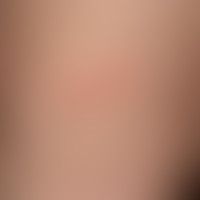
Erythema anulare centrifugum L53.1
Erythema anulare centrifugum: Characteristic single cell lesion with peripherally progressive plaque, which flattens centrally and is only recognizable here as a non raised red spot.
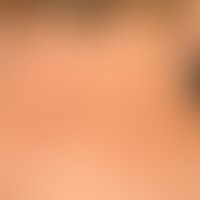
Lupus erythematosus tumidus L93.2
lupus erythematodes tumidus: chronic, relapsing disease pattern that has been active for months, completely without symptoms; succulent, surface-smooth, red plaques. high sensitivity to light. no hyperesthesia. ANA: negative; DIF: uncharacteristic. good response to antimalarial therapy.

Perioral dermatitis L71.0
Dermatitis perioralis, granulomatous type. multiple, chronically dynamic, continuously increasing for 3 months, periorally localized, disseminated, follicular, firm, itching and burning, red, rough, scaly papules, pustules and plaques. months of pre-treatment with corticoid ointments!

Inverted psoriasis L40.83
Psoriasis inversa: 69-year-old woman. 6 months at presentation. no manifestations of psoriasis present on the remaining integument. family history but positive: son with known psoriasis vulgaris.

Zoster B02.9
Zoster: in segmental distribution (Th4), grouped vesicles on reddened skin in a 38-year-old man. Moderate pain. Healing without complications. No postzosteric neuralgia. Here is a detailed picture with fresh grouped vesicles.

Cutaneous mastocytoma Q82.2
Mastocytomas, cutaneous: moderately consistency-propagated, brownish-reddish, blurred, maculopapular plaques; the Darian sign is positive (development of a wheal after rubbing the efflorescence).

Tuft hair L66.2
Tufted hairs:Folliculitis decalvans: Scar plate with wicklike tufts of hair in the centre, also in the marginal area of the scarring (see also under Folliculitis decalvans).
